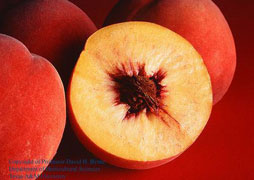


Home
Flowers &
Indoor Plants
Fruits & Nuts
Ornamentals
Vegetables
Special Topics
Resources
Glossary

 |
What about it? Despite the Latin name, peaches originated in China and not Persia. Nevertheless, they were cultivated in Iran for a long time before being introduced to Europe, probably arriving there before the first century BC. Peaches became popular in America in the early nineteenth century, thanks again, in part, to the efforts of Johnny Appleseed. Peaches are a type of tree fruit known as a "stone fruit," as are cherries, plums, and apricots. What is it used for? Peaches are used in baking or preserves. They are also delicious when eaten fresh. Where does it grow? How do we grow it? Peaches perform best only in the warm, protected areas of New York, including Long Island, the Hudson Valley, and areas near the largest bodies of water. Do not select areas where water does not drain away-, peach roots have no tolerance of "wet feet" Peaches prefer light, well-drained soils, providing adequate moisture can be maintained. Avoid heavy clay, and poorly-drained soils. Mild slopes are preferred for adequate air drainage. Plant peaches in rows 20 feet apart with 15 feet between each tree in those rows. Training and pruning will be necessary. What are its primary problems? Silver leaf and cytospora canker are responsible for the short life of many peach trees. Brown rot of the fruits is difficult to control, especially during wet seasons. Other common pests and diseases are leaf curl, scab, powdery mildew, bacterial leaf spot, crown gall Valsa canker, and mites. The most common insect found in peach trees is the peach tree borer. Plum curculia, Japanese beetles, and tarnished plant bugs attack the fruit. How do we harvest and store it? Peaches will not handle or store particularly well. Harvest carefully to avoid bruising.
© Copyright, Department of Horticulture, Cornell University. |




